Ứng dụng hoạt động khoảng trống thông tin nhằm tăng việc tham gia nói – nghiên cứu cải tiến đối với sinh viên chuyên anh năm nhất tại Đại học Hải Phòng
Mục tiêu của nghiên cứu này là cải thiện sự tham gia và hiệu suất nói của sinh viên lớp Ngôn ngữ Anh
5 - K17 (EM 5 - K17) - Khoa Ngoại ngữ (FLD) - Đại học Hải Phòng (HPU) bằng cách sử dụng các
hoạt động khoảng trống thông tin.
Nghiên cứu được chia thành hai vòng: Vòng 1 bao gồm bốn cuộc gặp và Vòng 2 bao gồm hai cuộc gặp. Các
dữ liệu đã được định lượng và định tính. Dữ liệu định tính thu được thông qua quan sát trong lớp và phỏng
vấn giáo viên và học sinh. Dữ liệu định lượng được lấy từ và danh sách kiểm tra quan sát và kiểm tra (thử
nghiệm trước, thử nghiệm tiến độ và sau thử nghiệm). Các hành động được thực hiện trong nghiên cứu này
được mô tả là các hoạt động khoảng trống thông tin bao gồm triển khai thực hành tiếng Anh trên lớp trong
quá trình dạy học, cải thiện từ vựng của vinh viên thông qua việc kể lại một câu chuyện trước lớp và có trao
thưởng cho sinh viên hoặc các nhóm có thành tích tốt nhất.
Kết quả nghiên cứu cho thấy rằng việc thực hiện các hoạt động khoảng trống thông tin có thể cải thiện
sự tham gia và hiệu suất nói của sinh viên.
Từ khóa: Hoạt động khoảng cách thông tin, tham gia nói, hiệu suất nói, nghiên cứu hành động.
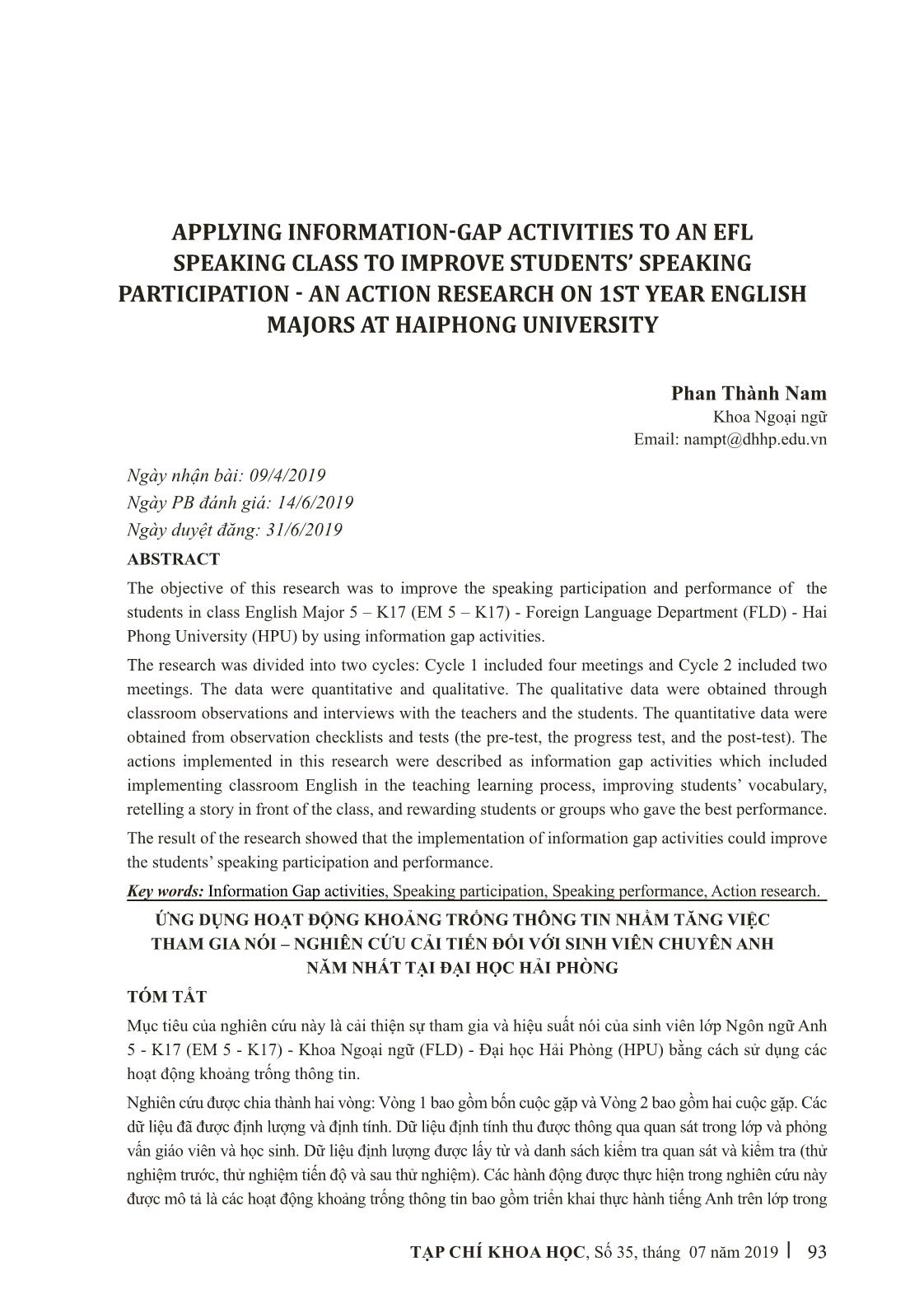
Trang 1
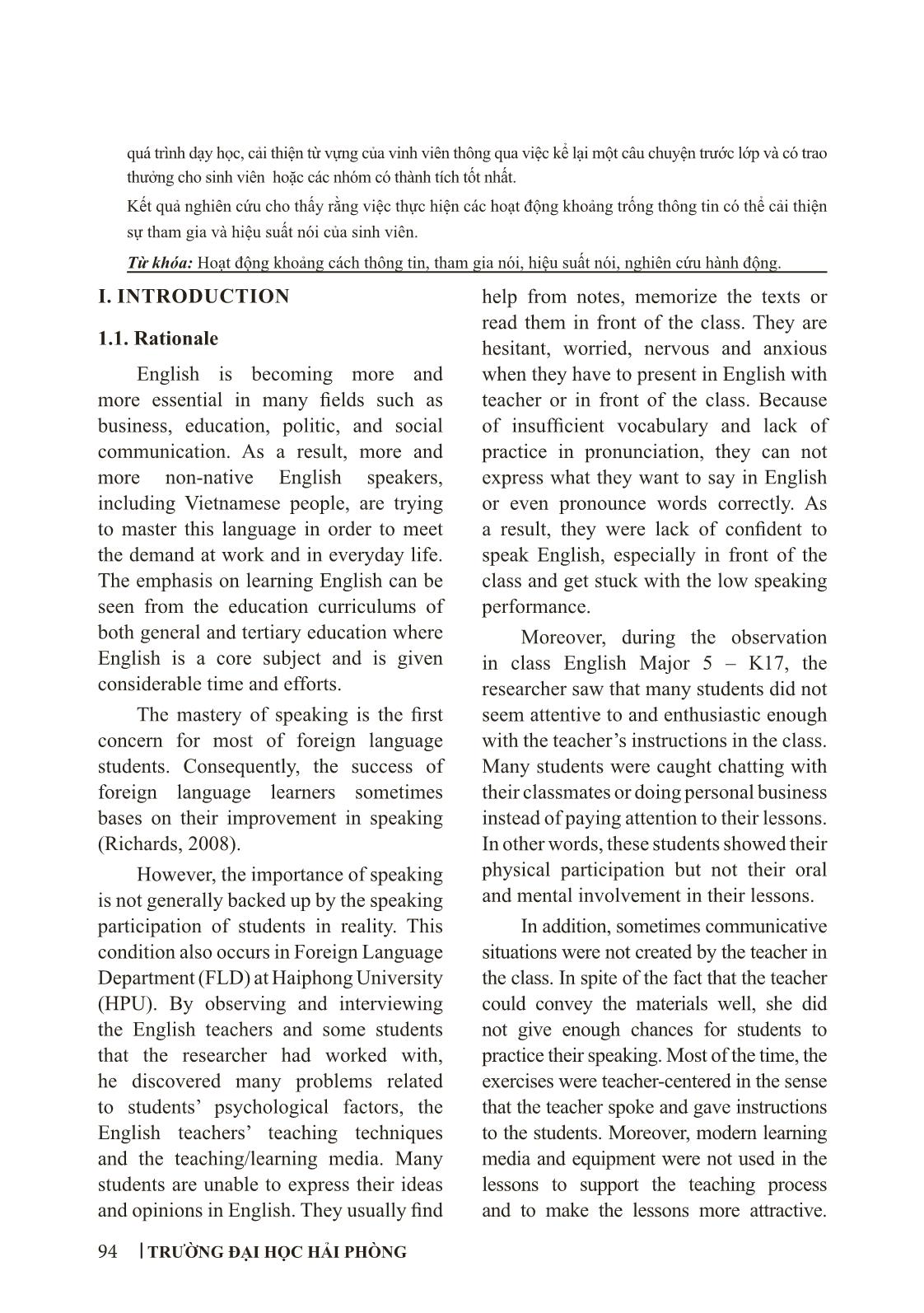
Trang 2
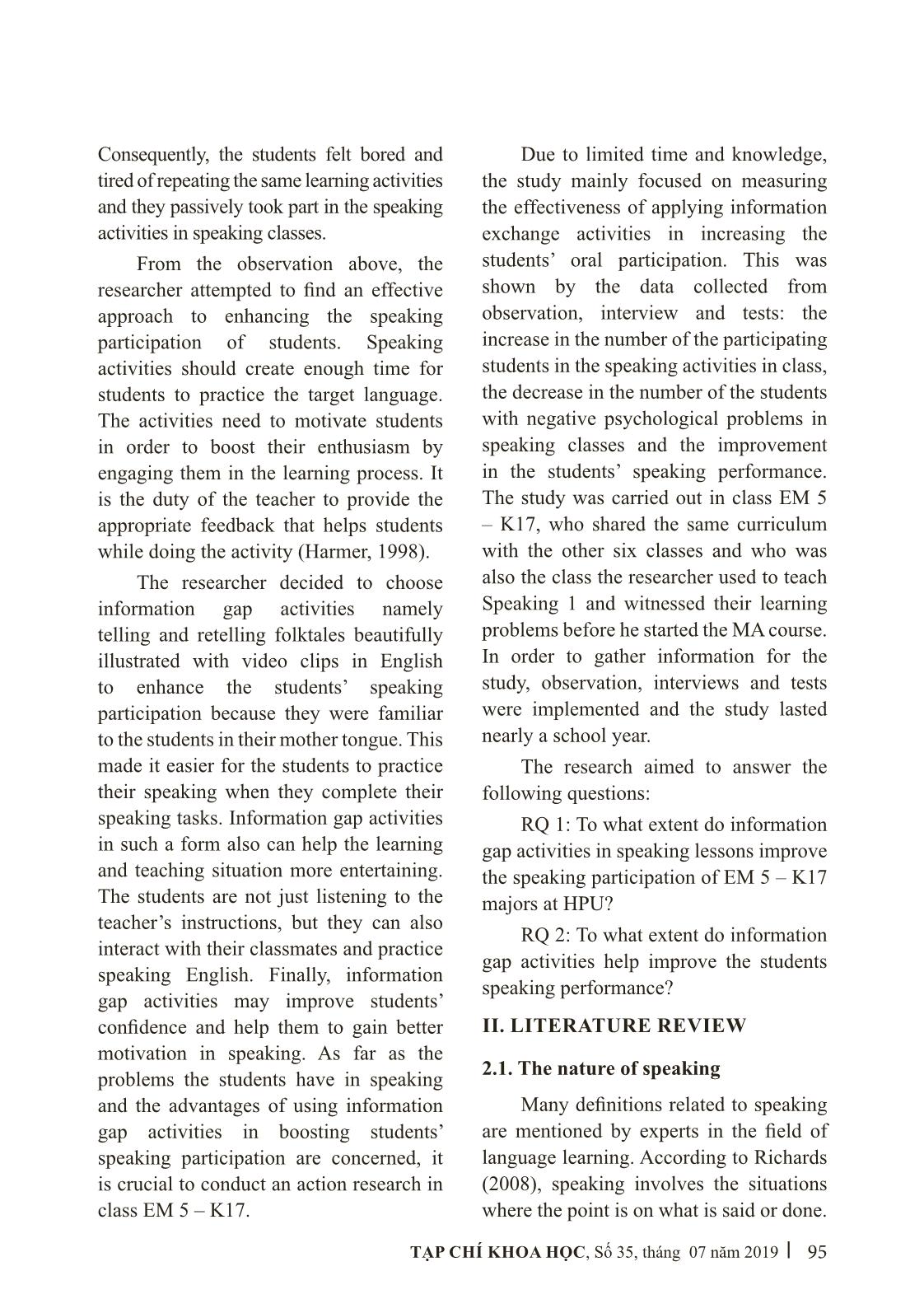
Trang 3
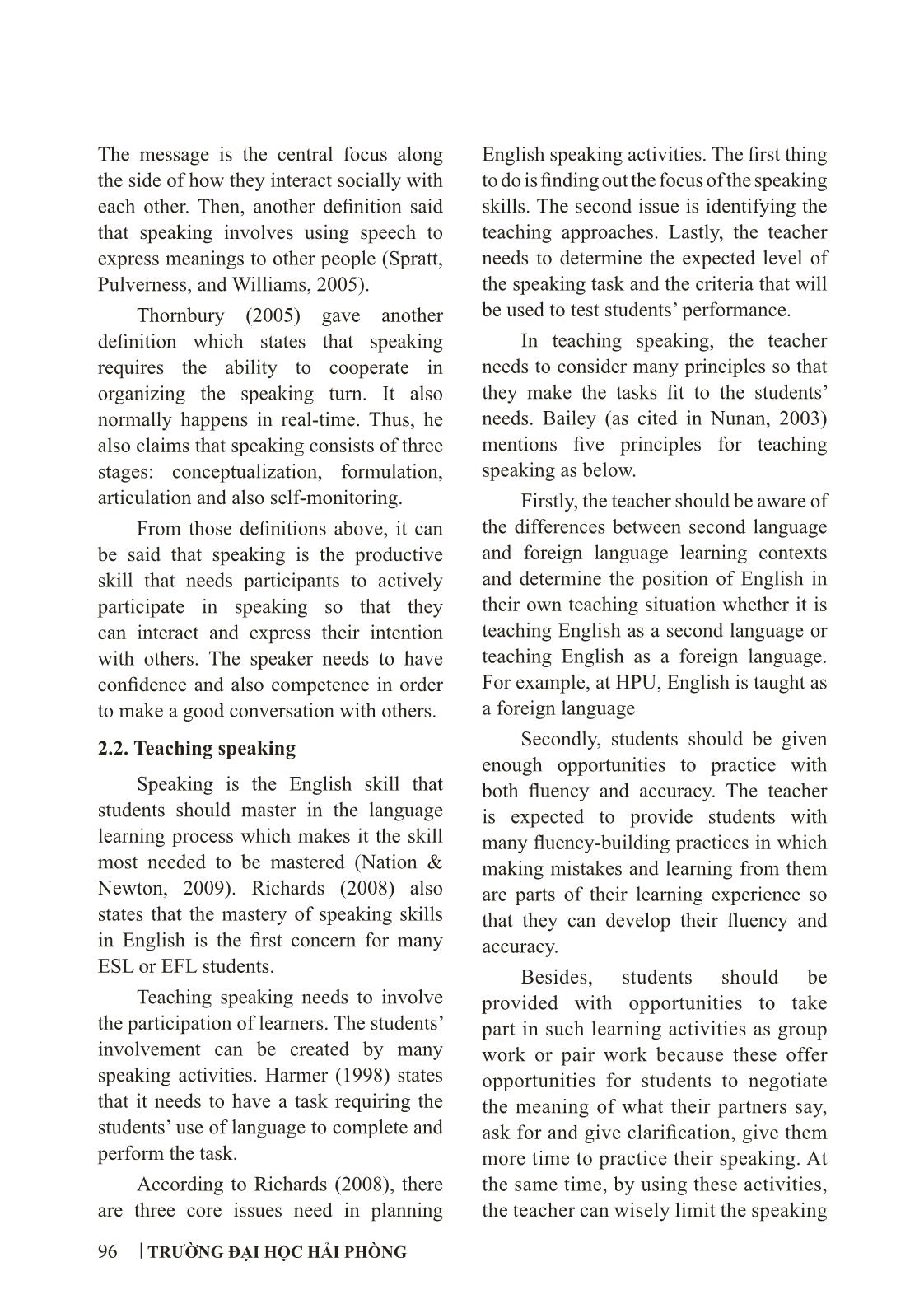
Trang 4
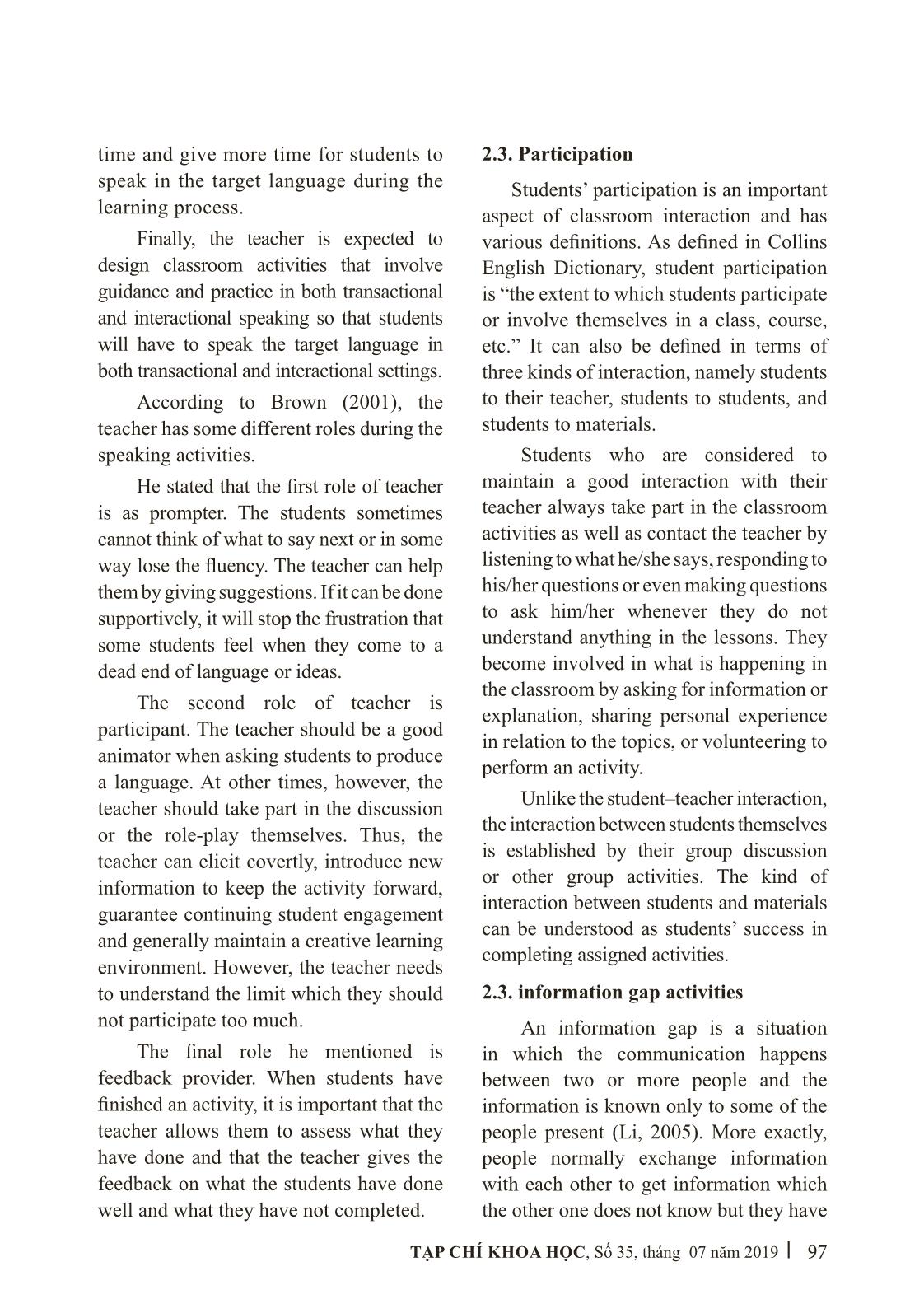
Trang 5
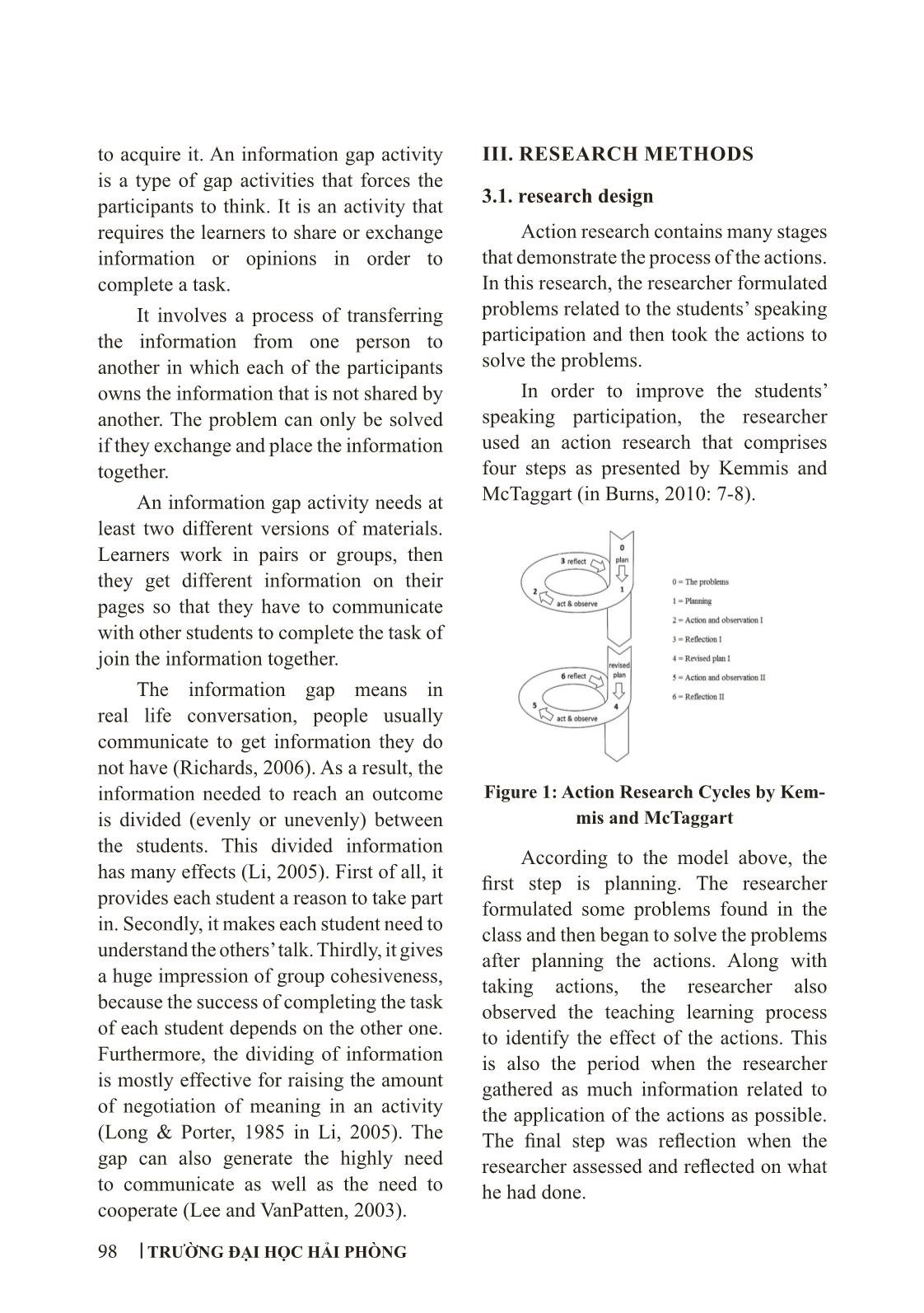
Trang 6
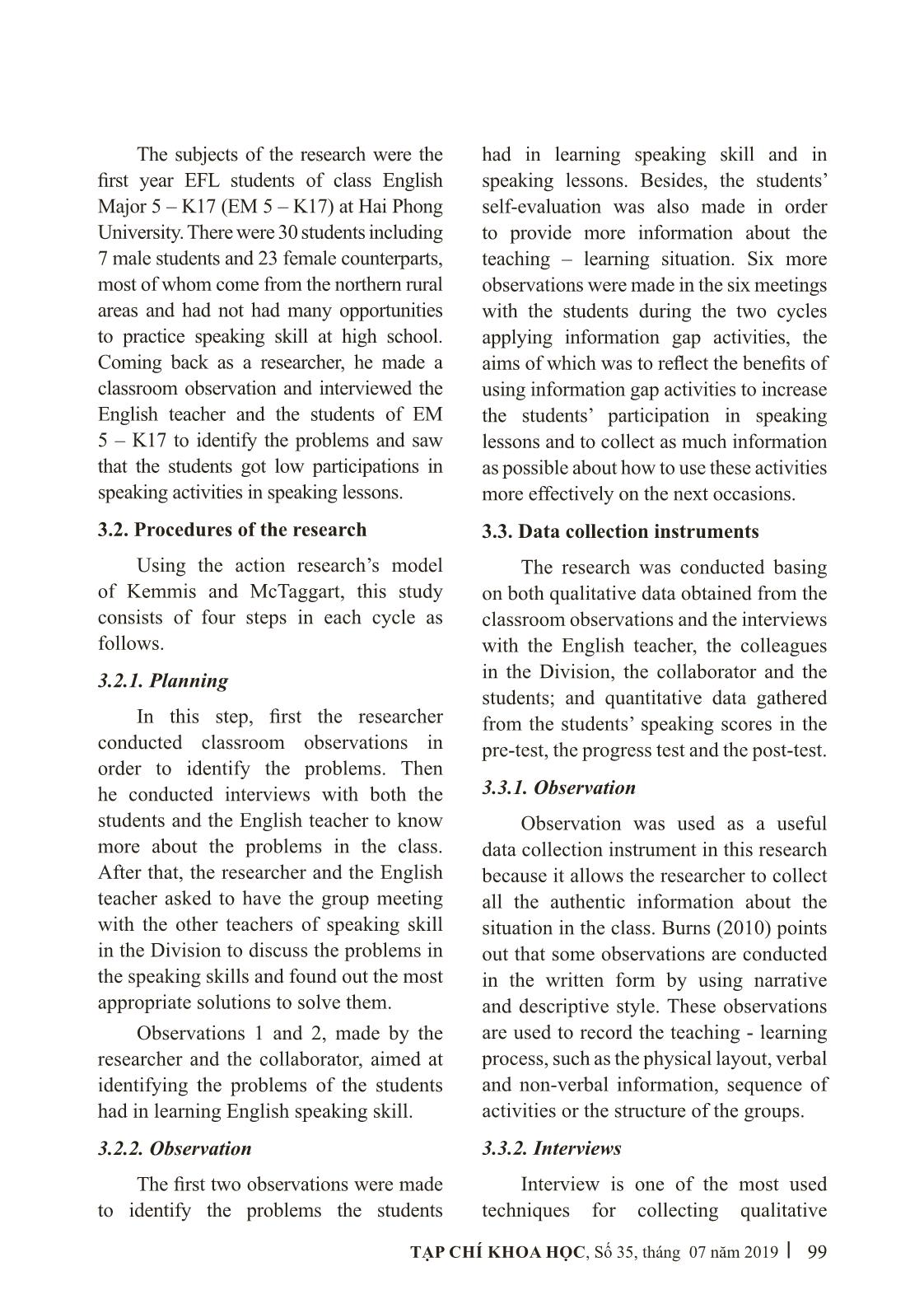
Trang 7
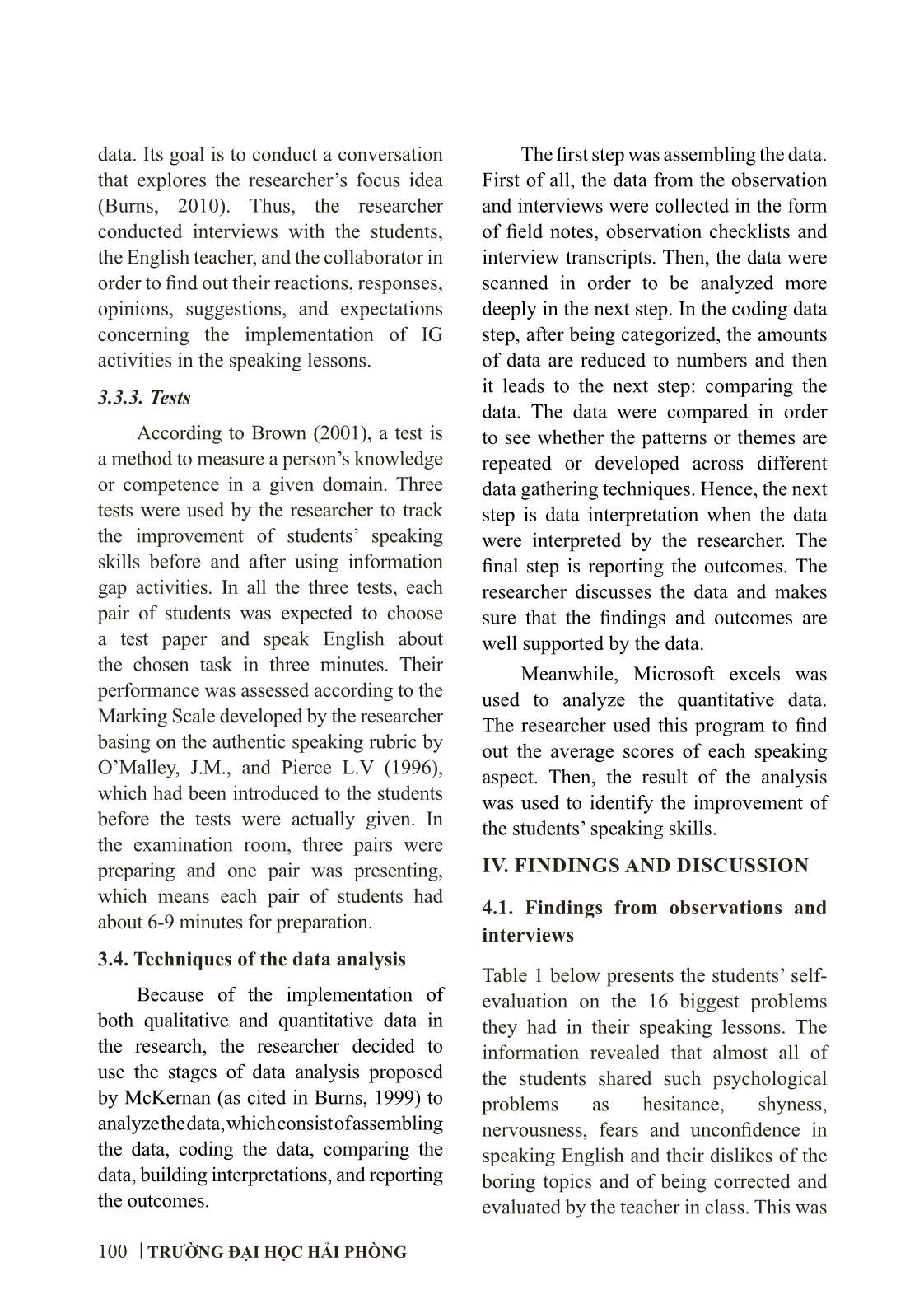
Trang 8
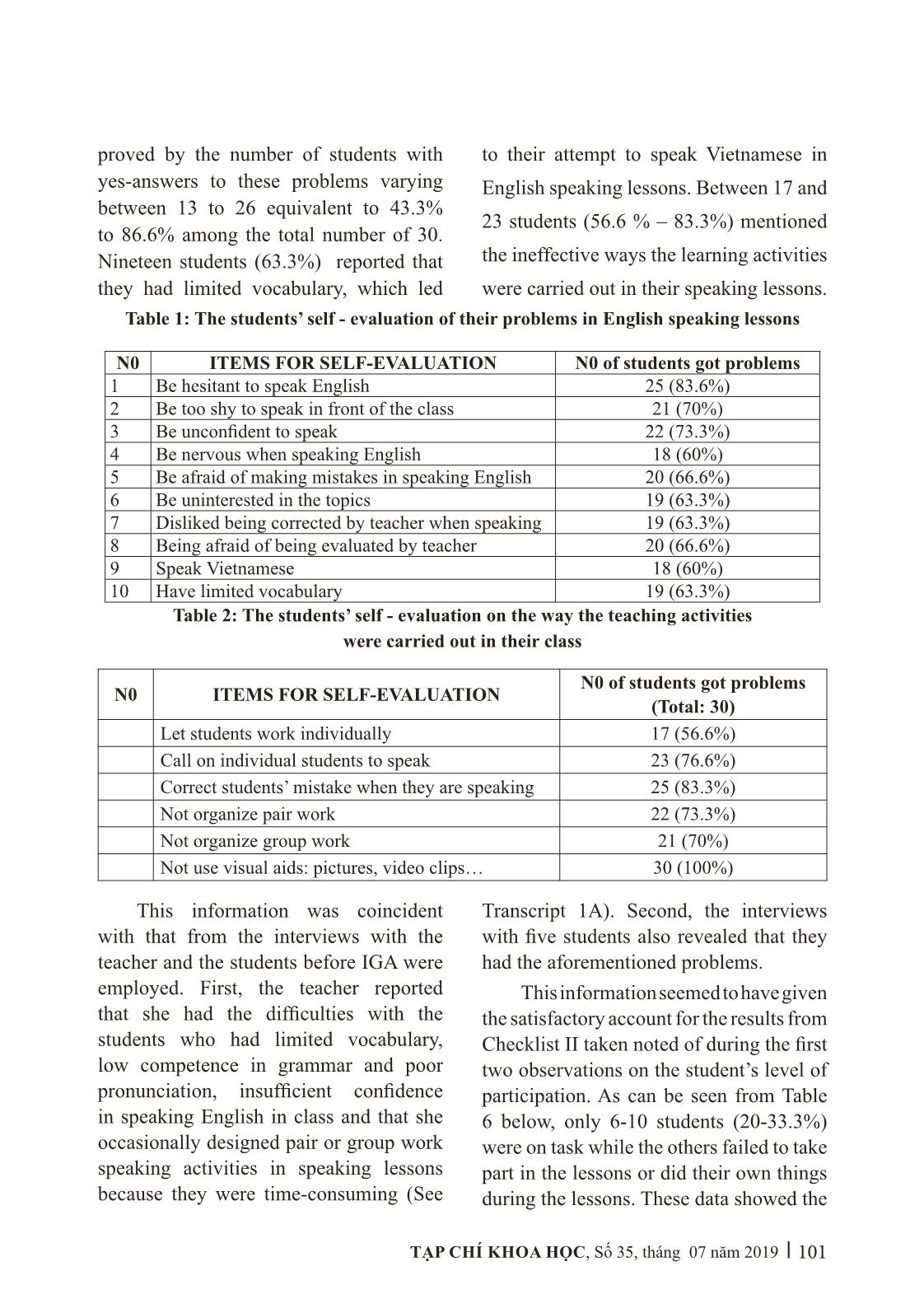
Trang 9
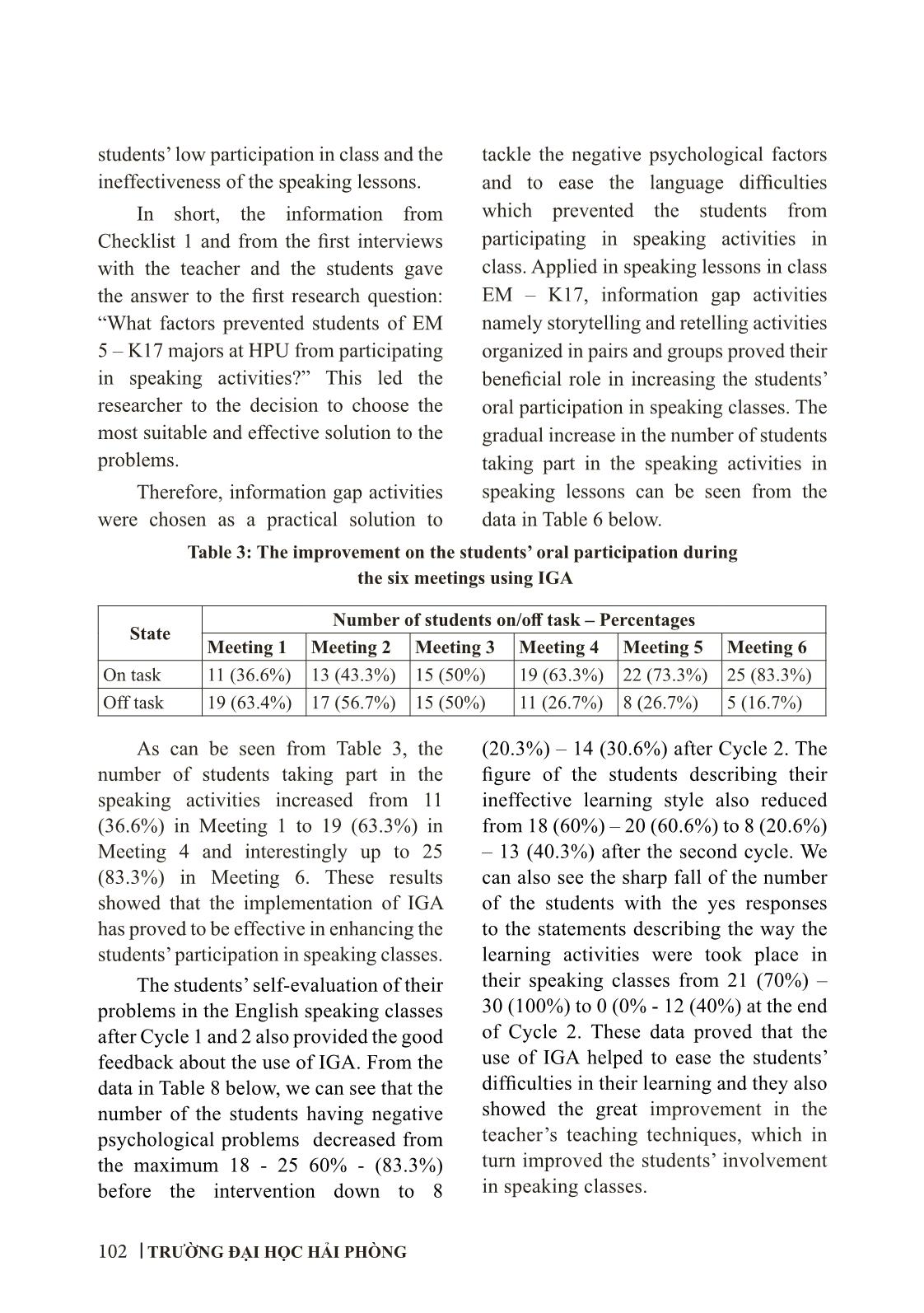
Trang 10
Tải về để xem bản đầy đủ
Tóm tắt nội dung tài liệu: Ứng dụng hoạt động khoảng trống thông tin nhằm tăng việc tham gia nói – nghiên cứu cải tiến đối với sinh viên chuyên anh năm nhất tại Đại học Hải Phòng
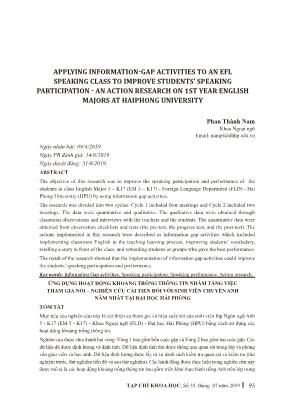
93TẠP CHÍ KHOA HỌC, Số 35, tháng 07 năm 2019 APPLYING INFORMATION-GAP ACTIVITIES TO AN EFL SPEAKING CLASS TO IMPROVE STUDENTS’ SPEAKING PARTICIPATION - AN ACTION RESEARCH ON 1ST YEAR ENGLISH MAJORS AT HAIPHONG UNIVERSITY Phan Thành Nam Khoa Ngoại ngữ Email: nampt@dhhp.edu.vn Ngày nhận bài: 09/4/2019 Ngày PB đánh giá: 14/6/2019 Ngày duyệt đăng: 31/6/2019 ABSTRACT The objective of this research was to improve the speaking participation and performance of the students in class English Major 5 – K17 (EM 5 – K17) - Foreign Language Department (FLD) - Hai Phong University (HPU) by using information gap activities. The research was divided into two cycles: Cycle 1 included four meetings and Cycle 2 included two meetings. The data were quantitative and qualitative. The qualitative data were obtained through classroom observations and interviews with the teachers and the students. The quantitative data were obtained from observation checklists and tests (the pre-test, the progress test, and the post-test). The actions implemented in this research were described as information gap activities which included implementing classroom English in the teaching learning process, improving students’ vocabulary, retelling a story in front of the class, and rewarding students or groups who gave the best performance. The result of the research showed that the implementation of information gap activities could improve the students’ speaking participation and performance. Key words: Information Gap activities, Speaking participation, Speaking performance, Action research. ỨNG DỤNG HOẠT ĐỘNG KHOẢNG TRỐNG THÔNG TIN NHẰM TĂNG VIỆC THAM GIA NÓI – NGHIÊN CỨU CẢI TIẾN ĐỐI VỚI SINH VIÊN CHUYÊN ANH NĂM NHẤT TẠI ĐẠI HỌC HẢI PHÒNG TÓM TẮT Mục tiêu của nghiên cứu này là cải thiện sự tham gia và hiệu suất nói của sinh viên lớp Ngôn ngữ Anh 5 - K17 (EM 5 - K17) - Khoa Ngoại ngữ (FLD) - Đại học Hải Phòng (HPU) bằng cách sử dụng các hoạt động khoảng trống thông tin. Nghiên cứu được chia thành hai vòng: Vòng 1 bao gồm bốn cuộc gặp và Vòng 2 bao gồm hai cuộc gặp. Các dữ liệu đã được định lượng và định tính. Dữ liệu định tính thu được thông qua quan sát trong lớp và phỏng vấn giáo viên và học sinh. Dữ liệu định lượng được lấy từ và danh sách kiểm tra quan sát và kiểm tra (thử nghiệm trước, thử nghiệm tiến độ và sau thử nghiệm). Các hành động được thực hiện trong nghiên cứu này được mô tả là các hoạt động khoảng trống thông tin bao gồm triển khai thực hành tiếng Anh trên lớp trong 94 TRƯỜNG ĐẠI HỌC HẢI PHÒNG I. INTRODUCTION 1.1. Rationale English is becoming more and more essential in many fields such as business, education, politic, and social communication. As a result, more and more non-native English speakers, including Vietnamese people, are trying to master this language in order to meet the demand at work and in everyday life. The emphasis on learning English can be seen from the education curriculums of both general and tertiary education where English is a core subject and is given considerable time and efforts. The mastery of speaking is the first concern for most of foreign language students. Consequently, the success of foreign language learners sometimes bases on their improvement in speaking (Richards, 2008). However, the importance of speaking is not generally backed up by the speaking participation of students in reality. This condition also occurs in Foreign Language Department (FLD) at Haiphong University (HPU). By observing and interviewing the English teachers and some students that the researcher had worked with, he discovered many problems related to students’ psychological factors, the English teachers’ teaching techniques and the teaching/learning media. Many students are unable to express their ideas and opinions in English. They usually find help from notes, memorize the texts or read them in front of the class. They are hesitant, worried, nervous and anxious when they have to present in English with teacher or in front of the class. Because of insufficient vocabulary and lack of practice in pronunciation, they can not express what they want to say in English or even pronounce words correctly. As a result, they were lack of confident to speak English, especially in front of the class and get stuck with the low speaking performance. Moreover, during the observation in class English Major 5 – K17, the researcher saw that many students did not seem attentive to and enthusiastic enough with the teacher’s instructions in the class. Many students were caught chatting with their classmates or doing personal business instead of paying attention to their lessons. In other words, these students showed their physical participation but not their oral and mental involvement in their lessons. In addition, sometimes communicative situations were not created by the ... . The researcher used this program to find out the average scores of each speaking aspect. Then, the result of the analysis was used to identify the improvement of the students’ speaking skills. IV. FINDINGS AND DISCUSSION 4.1. Findings from observations and interviews Table 1 below presents the students’ self- evaluation on the 16 biggest problems they had in their speaking lessons. The information revealed that almost all of the students shared such psychological problems as hesitance, shyness, nervousness, fears and unconfidence in speaking English and their dislikes of the boring topics and of being corrected and evaluated by the teacher in class. This was 101TẠP CHÍ KHOA HỌC, Số 35, tháng 07 năm 2019 proved by the number of students with yes-answers to these problems varying between 13 to 26 equivalent to 43.3% to 86.6% among the total number of 30. Nineteen students (63.3%) reported that they had limited vocabulary, which led to their attempt to speak Vietnamese in English speaking lessons. Between 17 and 23 students (56.6 % – 83.3%) mentioned the ineffective ways the learning activities were carried out in their speaking lessons. Table 1: The students’ self - evaluation of their problems in English speaking lessons N0 ITEMS FOR SELF-EVALUATION N0 of students got problems 1 Be hesitant to speak English 25 (83.6%) 2 Be too shy to speak in front of the class 21 (70%) 3 Be unconfident to speak 22 (73.3%) 4 Be nervous when speaking English 18 (60%) 5 Be afraid of making mistakes in speaking English 20 (66.6%) 6 Be uninterested in the topics 19 (63.3%) 7 Disliked being corrected by teacher when speaking 19 (63.3%) 8 Being afraid of being evaluated by teacher 20 (66.6%) 9 Speak Vietnamese 18 (60%) 10 Have limited vocabulary 19 (63.3%) Table 2: The students’ self - evaluation on the way the teaching activities were carried out in their class N0 ITEMS FOR SELF-EVALUATION N0 of students got problems (Total: 30) Let students work individually 17 (56.6%) Call on individual students to speak 23 (76.6%) Correct students’ mistake when they are speaking 25 (83.3%) Not organize pair work 22 (73.3%) Not organize group work 21 (70%) Not use visual aids: pictures, video clips 30 (100%) This information was coincident with that from the interviews with the teacher and the students before IGA were employed. First, the teacher reported that she had the difficulties with the students who had limited vocabulary, low competence in grammar and poor pronunciation, insufficient confidence in speaking English in class and that she occasionally designed pair or group work speaking activities in speaking lessons because they were time-consuming (See Transcript 1A). Second, the interviews with five students also revealed that they had the aforementioned problems. This information seemed to have given the satisfactory account for the results from Checklist II taken noted of during the first two observations on the student’s level of participation. As can be seen from Table 6 below, only 6-10 students (20-33.3%) were on task while the others failed to take part in the lessons or did their own things during the lessons. These data showed the 102 TRƯỜNG ĐẠI HỌC HẢI PHÒNG students’ low participation in class and the ineffectiveness of the speaking lessons. In short, the information from Checklist 1 and from the first interviews with the teacher and the students gave the answer to the first research question: “What factors prevented students of EM 5 – K17 majors at HPU from participating in speaking activities?” This led the researcher to the decision to choose the most suitable and effective solution to the problems. Therefore, information gap activities were chosen as a practical solution to tackle the negative psychological factors and to ease the language difficulties which prevented the students from participating in speaking activities in class. Applied in speaking lessons in class EM – K17, information gap activities namely storytelling and retelling activities organized in pairs and groups proved their beneficial role in increasing the students’ oral participation in speaking classes. The gradual increase in the number of students taking part in the speaking activities in speaking lessons can be seen from the data in Table 6 below. Table 3: The improvement on the students’ oral participation during the six meetings using IGA State Number of students on/off task – Percentages Meeting 1 Meeting 2 Meeting 3 Meeting 4 Meeting 5 Meeting 6 On task 11 (36.6%) 13 (43.3%) 15 (50%) 19 (63.3%) 22 (73.3%) 25 (83.3%) Off task 19 (63.4%) 17 (56.7%) 15 (50%) 11 (26.7%) 8 (26.7%) 5 (16.7%) As can be seen from Table 3, the number of students taking part in the speaking activities increased from 11 (36.6%) in Meeting 1 to 19 (63.3%) in Meeting 4 and interestingly up to 25 (83.3%) in Meeting 6. These results showed that the implementation of IGA has proved to be effective in enhancing the students’ participation in speaking classes. The students’ self-evaluation of their problems in the English speaking classes after Cycle 1 and 2 also provided the good feedback about the use of IGA. From the data in Table 8 below, we can see that the number of the students having negative psychological problems decreased from the maximum 18 - 25 60% - (83.3%) before the intervention down to 8 (20.3%) – 14 (30.6%) after Cycle 2. The figure of the students describing their ineffective learning style also reduced from 18 (60%) – 20 (60.6%) to 8 (20.6%) – 13 (40.3%) after the second cycle. We can also see the sharp fall of the number of the students with the yes responses to the statements describing the way the learning activities were took place in their speaking classes from 21 (70%) – 30 (100%) to 0 (0% - 12 (40%) at the end of Cycle 2. These data proved that the use of IGA helped to ease the students’ difficulties in their learning and they also showed the great improvement in the teacher’s teaching techniques, which in turn improved the students’ involvement in speaking classes. 103TẠP CHÍ KHOA HỌC, Số 35, tháng 07 năm 2019 Table 4: Students’ self – evaluation on the their problems after Cycle 1 and 2 N0 ITEMS FOR SELF-EVALUATION N0 of students got problems Before the intervention N0 of students got problems After Cycle 1 N0 of students got problems After Cycle 2 1 Be hesitant to speak English 25 (83.6%) 18 (60%) 14 (46.6%) 2 Be too shy to speak in front of the class 21 (70%) 16 (50.3%) 12 (40%) 3 Be unconfident to speak 22 (73.3%) 17 (56.6%) 13 (43.4%) 4 Be nervous when speaking English 18 (60%) 12 (40%) 8 (20.6%) 5 Be afraid of making mistakes in speaking English 20 (66.6%) 17 (56.6%) 14 (46.6%) 6 Be uninterested in the topics 19 (63.3%) 14 (46.6%) 11 (30.6%) 7 Disliked being corrected by teacher when speaking 19 (63.3%) 12 (40%) 9 (30%) 8 Being afraid of being evaluated by teacher 20 (66.6%) 14 (46.6%) 9 (30%) 9 Speak Vietnamese 18 (60%) 14 (46.6%) 8 (20.7%) 10 Have limited vocabulary 19 (63.3%) 15 (50%) 13 (43.4%) Table 5: Students’ self – evaluation on the way the teaching activities were carried out in their class after Cycle 1 and 2 N0 ITEMS FOR SELF- EVALUATION N0 of students got problems Before the intervention N0 of students got problems After Cycle 1 N0 of students got problems After Cycle 2 11 Let students work individually 17 (56.6%) 9 (30%) 6 (20%) 12 Call on individual students to speak 23 (76.6%) 16 (50.3%) 10 (30.3%) 13 Correct students’ mistake when they are speaking 25 (83.3%) 18 (60%) 12 (40%) 14 Not organize pair work 22 (73.3%) 3 (10%) 1 (3.3%) 15 Not organize group work 21 (70%) 2 (6.3%) 1 (3.3%) 16 Not use visual aids: pictures, video clips 30 (100%) 0 (0%) 0 (0%) It is clear that the students showed the great improvement on both the amount of participation they had in the speaking lessons and their language performance. As can be seen from Table 9, in the first 3 meetings it was observed that the students still experienced such negative psychological problems as hesitance, unconfidence, nervousness and fears; but in the next three meetings these problems did not seem to be the obstacles according to the observers’ opinions (3A/1D and 4 D). The other difficulties related to the students’ language skill were reported to be minimized in the last three meetings. Three among the four observers reported that the students’ speaking time was longer in Meeting 4 and 5 and especially all of them agreed that the students had the longer speaking time in the sixth meeting, which once more revealed the great effectiveness of using IGA in the speaking lessons. 104 TRƯỜNG ĐẠI HỌC HẢI PHÒNG 4.2. Findings from tests In addition to the findings from the classroom observation and interviews with the teacher of English and the students in Class EM K17, to evaluate the students’ progress in speaking performance to confirm the effectiveness of applying Information Gap Activities, the researcher also conducted tests including the pre- test, the progress test, and the post-test to assess the students’ speaking performance. The scoring process was conducted by the researcher and the collaborator. The results of the pre-test, the progress test, and the post-test are presented below. Table 6: The result ofthePre-test in each aspect Rater Fluency Accuracy Vocabulary Rater1 1.17 1.3 1.37 Rater2 1.3 1.4 1.4 Mean Score 1.24 1.35 1.39 Table 7: The result oftheProgress test in eachaspect Rater Fluency Accuracy Vocabulary Rater1 2.14 2.05 2.11 Rater2 2.26 2.11 2.17 Mean Score 2.20 2.08 2.14 Table 8: The result ofthePost-test in each aspect Rater Fluency Accuracy Vocabulary Rater1 3.13 3.03 3.13 Rater2 3.13 3.00 3.03 Mean Score 3.13 3.01 3.08 In the Pre-test, the students’ speaking performance was a little poor. They could not speak English fluently when they exchanged the information about the assigned topics. Most of them seemed afraid of speaking English. They showed their limited vocabulary and their poor pronunciation. After information gap activities were conducted in the four meetings of speaking classes in Cycle 1, there could be seen certain improvement in the students’ speaking performance. In Cycle 2, the application of information gap activities in the second cycle proved to successfully achieve the goal of improving the students’ participation in speaking classes, which can be seen from the result of the performance of students in the post-test. The following table presents the comparison of the students’ mean scores in the pre-test, the progress test, and the post- test with the gain score of each aspect. Table 9:TheComparison oftheStudents’Mean Scores intheTests Test Fluency Accuracy Vocabulary Pre-test 1.24 1.35 1.39 Progress test 2.20 2.08 2.14 Post-test 3.13 3.01 3.08 Gain score 1.86 1.66 1.69 105TẠP CHÍ KHOA HỌC, Số 35, tháng 07 năm 2019 As can be seen from the table above, the students’ mean scores in the speaking aspects increased after the information gap activities were applied in the teaching - learning process. The students’ mean scores in fluency increased 1.86 from 1.24 in the pre- test to 3.13 in the post- test. The accuracy aspect increased from 1.35 in the pre-test to 3.01 in the post-test. The students’ mean scores in vocabulary aspect also increased 1.69 from 1.39 in the pre-test to 3.08 in the post-test. The general findings of the students’ mean scores in the pre-test, the progress test, and the post-test are presented in the following table. Table 10:Thegeneral findings ofthestudents’mean scores inthetests Pre-test Progress test Post-test Gain score Mean Scores 1.33 2.14 3.07 1.74 According to the information presented in thetable, it can be seen that there was great improvement in the students’ mean scores from the pre-test, the progress test, and finally the post-test. The table also revealed that the students’ mean scores in the post-test was higher than those in the pre-test and in the progress test. The gain score was 1.74. In conclusion, the results from the three tests once more confirmed the students’ improvement in speaking performance in pairs and groups which resulted from the effectiveness of using information gap activities. V. CONCLUSION The research was conducted on April 2017 with a view to improving the speaking participation of the first year English majors at Foreign Language Department of Hai Phong University by using information gap activities. From the analysis of the findings of the research in the previous chapter, it can be stated that the use of information gap activities successfully enhanced the students’ speaking participation. In other words, the progress of the students’ speaking participation was greatly attributed to the implementation of information gap activities in the teaching - learning process. This can be seen in the following analysis. Firstly, being conducted in pairs and/ or in groups, the information gap activities created more chances for the students to practice their speaking by enabling them to interact with the other friends. Secondly, the improvement could be seen from the teaching learning process. Thirdly, the students’ vocabulary became much richer than it used to be. One more conclusion is that during the application of Information Gap Activities, the teachers had many difficulties in time management and class management. As discussed in the previous chapter, while the students working in pairs and groups they were making a lot of unexpected noise and it was not easy to overcome this problem. Another difficulty for the teachers is that these activities are very time-consuming, so the teacher hardly meets the time requirements. Instead of carrying everything in class, the teachers have to set the final part of the lesson as homework. 106 TRƯỜNG ĐẠI HỌC HẢI PHÒNG REFERENCES 1.Brown, H. D., & Lee, H. (2001). Teaching by principles: An interactive approach to language pedagogy (Vol. 1, p. 994). Englewood Cliffs, NJ: Prentice Hall Regents. 2. Li, Y. (2005). Speaking Activities: Five Features. US-China Foreign Language, 9, 71-75. 3. Richards, J. C., & Rodgers, T. S. (2001). Communicative language teaching. Approaches and methods in language teaching, 2. 4. Spratt, M., Pulverness, A., & Williams, M. (2011). The TKT course. Ernst Klett Sprachen. 5. Thornbury, S. (2012). Speaking instruction. The Cambridge guide to pedagogy and practice in second language teaching, 198-206.
File đính kèm:
 ung_dung_hoat_dong_khoang_trong_thong_tin_nham_tang_viec_tha.pdf
ung_dung_hoat_dong_khoang_trong_thong_tin_nham_tang_viec_tha.pdf

